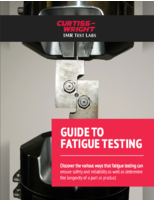Beckman Coulter Life Sciences Publishes White Paper for ClearLLab Control Cells, Validating First 10C System for Clinical Lab
Miami, USA (August 5, 2019) ─ Beckman Coulter Life Sciences has published a flow cytometry white paper to support the gating strategies behind its newly launched IVD ClearLLab Control Cells - the first application-specific control for leukemia and lymphoma* immunophenotyping in the clinical laboratory.
The control cells have been designed specifically to verify the performance of the ClearLLab 10C panels of reagents and staining procedure, cleared earlier this year by the Food and Drug Administration (FDA) for both lymphoid and myeloid lineages.
Flow cytometric immunophenotyping is increasingly used to aid in the diagnosis of hematolymphoid malignancies. The freely available ClearLLab Control Cells white paper details the flow cytometry gating strategy for B, T, M1 or M2 tubes.
“Controls are key for all assays, but until now most labs have had to design their own solutions,” stressed Jeannine Holden MD, Chief Medical Officer, Beckman Coulter. “ClearLLab Control Cells offer the ideal combination of convenience and consistency, and permit flow cytometry laboratories to streamline this aspect of testing.”
“The ClearLLab gating strategy provides the lab with an easy, simple and consistent assessment of every relevant cell population,” added Dr. Mario Koksch, Flow Cytometry Business Unit Vice President and General Manager, Beckman Coulter Life Sciences. “With the ClearLLab 10C System, labs now have access to a portfolio of standardized, diagnostic tools, freeing up time previously spent on extensive manual validation, preparation and QC tasks.”
ClearLLab Control Cells are available in both normal and abnormal controls - the only difference is that the abnormal control has a blast-like population that is CD45 dim, and expresses CD34, CD123 and CD117. They include assay values for the 27 markers currently available on the four ClearLLab10C panels. These markers are consistent with WHO and Bethesda guidelines(1), (2).
The control cells are liquid preparations of stabilized human erythrocytes and leukocytes (lymphocytes, monocytes, and granulocytes) that have lysing, light scatter, antigen expression, and antibody staining properties representative of those found in human whole blood specimens.
Erythrocytes function as the lysable component, with leukocytes forming the positive cell component. The surface antigens present on the targeted cells bind to the antibodies in the ClearLLab 10C panels, and include CD34, CD117 and CD123. Multiple lots of both fresh (*T0M) and aged (*T3M+Op-1M) control cells were stained with each of the four ClearLLab 10C panels to assess the staining signal, resolution of each antigen as well as specimen stability.
Figure 1 looks at two markers, Krome Orange (CD45-KrO) and APC (CD34-APC), comparing the plots generated by fresh and aged analysis. The full analysis is given in the white paper.
Figure 1: Snapshot of TOM and T3M+ Op-1M plots
The fresh (T0M) control cell specimen was tested within 2 weeks of the post-production date. The aged (T3M+ Op-1M) control cell was tested 3-month close-vial plus a 1-month open-vial post production date.
The ClearLLab 10C System incorporates the company’s new Kaluza C software to streamline and standardize clinical QC reporting to international guidelines. The four dry pre-mixed antibody tubes also use the company’s DURA Innovations technology, eliminating the need to manually pipette the antibodies(3), (4).
“The use of dry, preformulated reagents with the ClearLLab 10C System decreases the potential for human error, further improving overall lab efficiency,” concluded Dr. Koksch.
Click the following link to access the Control Cells White Paper: https://info.beckmancoulter.com/l/60792/2019-08-02/gqqhqq/60792/272849/FLOW_5732WP07.19_ClearLLab_10C_Control_Cells_White_Paper.pdf
AACC Annual Meeting
Beckman Coulter Life Sciences is on booth # 3201 at the 71st American Association for Clinical Chemistry (AACC) Annual Scientific Meeting and Clinical Laboratory Expo (CLE) in Anaheim California, from August 4 to 8, 2019.
About Beckman Coulter Life Sciences
Beckman Coulter develops, manufactures and services products that simplify, automate and innovate complex biomedical testing and industrial manufacturing. More than 275,000 Beckman Coulter systems are currently used in diagnostic and research laboratories and manufacturing facilities around the world. Please visit www.beckman.com if you’d like to know more. Follow Beckman Coulter Life Sciences on Twitter @BCILifeSciences; Facebook: www.facebook.com/BCILifeSciences and LinkedIn.
*For lymphoma this refers to Non-Hodgkin Lymphoma only
References
1 Vardiman JW, Arber DA, Brunning DR et al. The 2008 revision of the World Health Organization (WHO) classification of myeloid neoplasms and acute leukemia: rationale and important changes. Blood 2009 114:937-951; doi: 10.1182/blood-2009-03-209262.
2 Davis BH, et al. 2006 Bethesda International Consensus Recommendations on the Immunophenotypic Analysis of Hematolymphoid Neoplasia by Flow Cytometry: Optimal Reagents and Reporting for the Flow Cytometric Diagnosis of Hematopoietic Neoplasia. Cytometry Part B (Clinical Cytometry 2007 72B: S5-S13
3 Rajab A, Axler O, Leung J, Wozniak M, Porwit A. Ten- color 15-antibody flow cytometry panel for immunophenotyping of lymphocyte population. International Journal of Laboratory Hematology 2017 May;39 Suppl 1:76-85. doi: 10.1111/ijlh.12678.
4 Smallwood C, Galama L, Apoll L, Heinrich KH, Demers J, Buchanan S. Examining the economic impact of laboratory defined testing a flow cytometry immunophenotyping for hematologic malignancies: an analysis of heath resource utilization. Poster session presented at: International Society for Pharmacoeconomics and Outcomes Research (ISPOR), 18th Annual European Congress, Milan, Italy. November 09-13, 2015.




